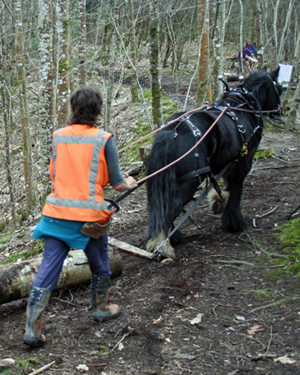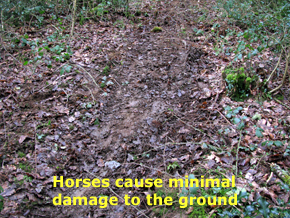- Home |
- Horse Logging |
- Bracken Control |
- Charcoal |
- Training/Demos |
- Harrowing |
- Equipment |
- Experience |
- Horse Tales |
- Contact Us |
- Links
Horse Logging

 The ancient art of horse logging has been enjoying a resurgence of interest in recent years. With the benefit of some modern forestry and agricultural engineering, and the ongoing development of traditional equipment in the United States, horse logging takes from the best of traditional and modern day. Carnog Working Horses can offer a full service of felling and extraction using horses.
The ancient art of horse logging has been enjoying a resurgence of interest in recent years. With the benefit of some modern forestry and agricultural engineering, and the ongoing development of traditional equipment in the United States, horse logging takes from the best of traditional and modern day. Carnog Working Horses can offer a full service of felling and extraction using horses.
The most common method for moving timber is ‘Snigging’ or ‘Tushing’. This is where the log is chained up and dragged behind the horse, using traces which are attached to a simple swingle tree bar (far left). Logs can be dragged up to 200 metres (depending on the terrain) using this technique. This simple method has been used for centuries and still is an effective way to get timber from the felling spot out of the woodland. As the log balances the horse, it can even be used on quite steep slopes.
The following video was shot during Carnog's work in Vention Wood in the Heddon Valley for the North Devon National Trust. We were clearing felled trees from an oak wood to the edge of the track for removal by a loader. The video shows how suitable horses are for working in such a restricted environment.
Larger logs can be transported using a timber arch or forwarder. And all logs can also be taken much larger distances using the horse-drawn timber arch or forwarder (top right).
 Horse logging comes into its own when land is particularly steep and man-made vehicles cannot cope. Horses can pull logs (or other objects such as fencing poles and wire) up or down quite steep slopes. This is especially good on those steep Welsh hillsides.
Horse logging comes into its own when land is particularly steep and man-made vehicles cannot cope. Horses can pull logs (or other objects such as fencing poles and wire) up or down quite steep slopes. This is especially good on those steep Welsh hillsides.
Horse power is also a good choice when there is limited infrastructure or space within the woodland. A horse can work in quite limited areas and can access wet or soft areas whilst doing minimal damage to the ground. This means horse-logging is also a good choice when there is a sensitive biodiversity or archaeological interest on the land, such as in a SSSI. Timber extraction with horses is a good choice when managing PAWs (Planted Ancient Woodland) and areas of natural regenerating woodland.
First and second thinnings and a final crop can all be extracted using horses. Single-tree extraction is a perfect job for a horse and they can work to safely remove wind-blown trees.
|
|---|
Carnog Working Horses can offer a full service of felling and extraction. Barbara is fully NPTC trained for felling and cross-cutting CS30, 31, 32. Other skilled chainsaw operatives can be brought into the team as and when required. If you think that you might be interested in using horse-power in your woodland, then please get in touch for more details or advice. Contact Carnog Working Horses.
back to top

